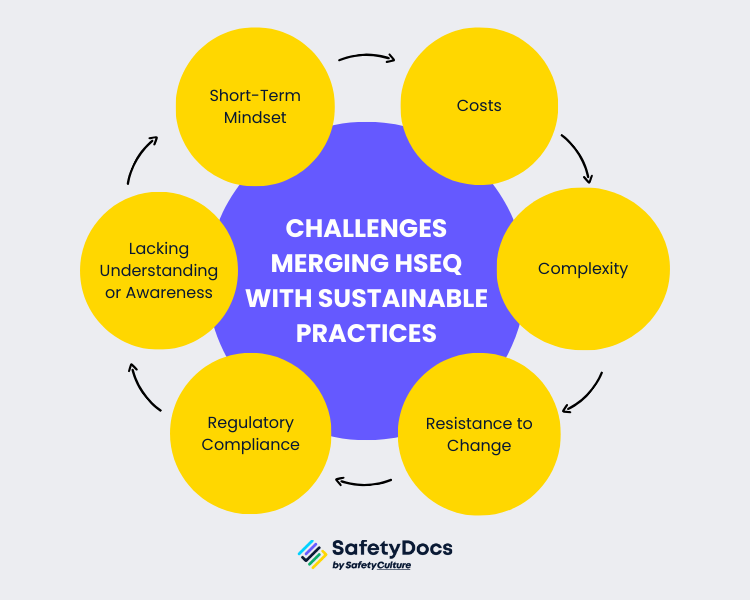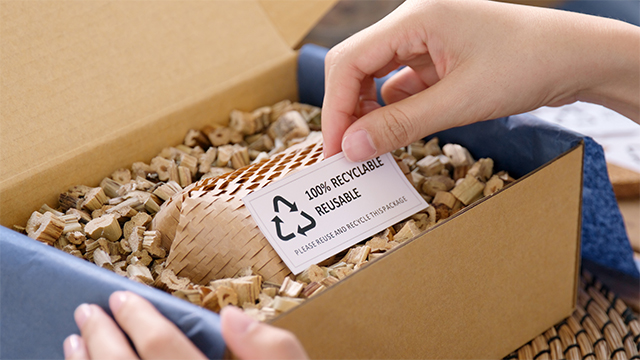Environmental Sustainability stands at the forefront of many business strategies as companies strive to align their economic development and goals with environmental and social considerations. According to a survey by Capterra, 96% of Australians claim to either 'definitely' know the meaning of Sustainability (54%) or are a bit familiar with it (42%). Additionally, 61% of Australians consider a company's business sustainability actions when deciding whether or not to purchase a product.
Let's delve deeper into the role of Health, Safety, Environment, and Quality (HSEQ) in promoting a successful sustainability strategy. We'll explore how Australian companies can leverage these principles to drive change, create value, and contribute to a more sustainable future.
What are Sustainable Business Practices
Sustainability means conducting business to meet present needs without compromising future generations' ability to meet their own. It is a balancing act between economic growth, environmental protection, occupational health, and social responsibility.
Sustainability initiatives or practices are processes and strategies businesses adopt to manage their operations to minimise negative environmental, societal, and economic impacts. These practices have three key aspects: economic viability, social responsibility, and environmental stewardship.
- Economic Viability: This involves managing resources efficiently, making prudent financial decisions, and creating a business model that can adapt to market changes.
- Social Responsibility: This aspect focuses on a business's impact on society. It includes treating employees fairly, investing in employee development, ensuring diversity and inclusion, and maintaining ethical labour practices.
- Environmental Stewardship: This refers to a business's efforts to minimise its adverse impact on the environment. This could involve reducing energy use, minimising waste, using sustainable materials, implementing recycling programs, etc.
Examples of Sustainability in Business
Here are some examples of sustainable business practices:
- Energy Efficiency: Businesses reduce their environmental impact and costs by implementing energy-saving measures such as using renewable energy, adopting efficient lighting systems, and optimising heating/cooling.
- Supply Chain Sustainability: Companies can promote Sustainability by partnering with suppliers that share the same values and adhere to sustainable development. It could mean choosing suppliers who maintain ethical labour practices, sourcing locally to reduce transportation emissions, or choosing renewable materials with a lower environmental impact.
- Waste Reduction: Adopting circular economy principles such as recycling and reducing waste generation can help businesses reduce their environmental footprint and save costs.
- Engaging in Community Development Projects: Companies can engage in projects that benefit their communities, such as supporting education programs or community service initiatives.
- Implementing Fair Labour Practices: Businesses foster social responsibility by ensuring ethical labour practices, fair wages, and safe working conditions for employees.
- Transparency and Reporting: Sustainable businesses are often transparent about their sustainability efforts and regularly report on environmental and social performance.
Importance of Sustainable Business Practices
Businesses must embrace sustainability to address pressing global issues such as climate change, resource depletion, and social responsibility. Beyond ethical considerations, sustainable practices often lead to cost savings, operational efficiency, increased competitiveness, and enhanced brand reputation. Here are other key reasons why businesses should prioritise Sustainability:
Environmental Protection
By adopting a sustainable business strategy, you can help reduce their environmental and carbon footprint further, conserve natural resources, and protect ecosystems and biodiversity.
Economic Performance
Sustainable businesses often perform better economically.
They use resources more efficiently, which can lead to cost savings. They also tend to be innovative, which can lead to new opportunities.
Social Equity
Sustainable business practices promote social equity by ensuring fair treatment of employees, supporting community development, and promoting diversity and inclusion. This can lead to a more engaged workforce, increased employee satisfaction, and a positive impact on the local community.
Market Competitiveness
With the growing consumer demand for ethically sourced and environmentally friendly products, businesses that embrace Sustainability can gain a competitive edge in the market. This can increase customer loyalty and brand reputation.
Reputation and Brand Value
Businesses that demonstrate a commitment to Sustainability can enhance their reputation and brand value, helping them to attract and retain customers, employees, and investors. This can also mitigate environmental and social risks to the business.

HSEQ and Sustainability
Health, Safety, Environment, and Quality (HSEQ) is a management approach that encompasses a set of principles and practices to ensure the health and safety of employees, protect the environment, and maintain high product and service quality. Compliant with ISO 9001, ISO 45001, and ISO 14001, the HSEQ framework involves risk assessments, compliance with regulations, and continuous improvement processes.
HSEQ protocols can significantly impact Sustainability by promoting responsible business practices. Here are some ways that HSEQ intersects with Sustainability:
- Risk Management: Implementing HSEQ protocols can help businesses identify and mitigate risks associated with environmental impacts, safety hazards, and quality control issues. This leads to more sustainable operations that minimise adverse effects on people and the environment.
- Compliance: HSEQ frameworks often incorporate regulations related to Sustainability, such as environmental laws and labour standards. By ensuring compliance with these regulations, businesses can demonstrate their commitment to Sustainability and avoid legal consequences.
- Continuous Improvement: HSEQ frameworks promote a culture of constant improvement, where businesses regularly assess their operations, identify areas for improvement, and implement actions to become more sustainable.
- Employee Well-being: The health and safety aspect of HSEQ ensures that employees are protected from workplace hazards, promoting their well-being. This can lead to a more engaged and productive workforce, resulting in long-term Sustainability for the business.
Benefits of Integrating HSEQ with Sustainability
Improved Risk Management
Integrating HSEQ with Sustainability leads to more comprehensive risk management. Companies can prevent accidents, mitigate financial losses, and protect their reputation by identifying and addressing potential hazards and risks.
Enhanced Regulatory Compliance
By aligning HSEQ with their sustainability objectives, organisations ensure compliance with regulations, mitigate risks, enhance their reputation, and promote a safety and environmental responsibility culture. This proactive approach helps companies avoid costly fines, legal complications, and reputational damage while fostering long-term success and sustainable growth.
Cost Reduction and Efficiency
Efficiency gains often accompany sustainability efforts. Companies can cut costs and improve their bottom line by optimising processes to reduce waste and resource consumption.
Enhanced Reputation and Brand Value
Consumers and investors increasingly favour companies with strong Sustainability and HSEQ track records. Integration can enhance a company's reputation and increase its brand value.
Stakeholder Engagement
Stakeholders appreciate organisations prioritising their well-being, including customers, employees, and communities. Integration fosters better stakeholder relationships.
Employee Morale and Productivity
When organisations prioritise the health and well-being of their employees, it creates a sense of safety and engagement among the workforce. This positive environment not only boosts morale but also enhances productivity levels.
Innovation and Competitive Advantage
Sustainability challenges drive innovation. Companies that integrate HSEQ with Sustainability gain a competitive edge by developing cutting-edge products and services.
Resource Conservation
Sustainability encompasses the conscious effort of reducing resource consumption and minimising waste generation. This approach to Sustainability involves mindful decision-making, responsible resource management, and promoting circular economy principles.
Long-Term Viability
Integration is paramount for establishing a company's long-term endurance and Sustainability. By considering long-term Sustainability, organisations can weather economic and environmental storms.

Challenges When Merging HSEQ with Sustainable Practices
While there are clear benefits to integrating HSEQ with Sustainability, businesses may need help implementing this approach. Some common obstacles include:
- Costs: Implementing sustainable practices can come with significant upfront costs, such as investing in renewable energy or implementing waste reduction measures. This may be a financial burden for some businesses.
- Complexity: The intersection of HSEQ and Sustainability can lead to complex processes and procedures requiring specialised knowledge and resources to implement effectively.
- Resistance to Change: Some employees or stakeholders may resist changes that come with integrating HSEQ and Sustainability, especially if it involves significant changes to established procedures or policies.
- Regulatory Compliance: While complying with regulations is a crucial aspect of HSEQ, keeping up with ever-changing environmental laws and standards can be challenging for businesses.
- Lack of Understanding or Awareness: Not everyone in an organisation understands the importance of Sustainability and its significance to HSEQ. This lack of understanding can hinder the implementation of sustainable practices.
- Short-Term Mindset: Some businesses prioritise short-term gains over long-term sustainability measures, which can prevent them from fully embracing sustainable practices.
Ways to Assess HSEQ's Role in Sustainability
Performance Metrics and Key Indicators
One of the most effective ways to assess the role of Health, Safety, Environment, and Quality (HSEQ) in Sustainability is by establishing clear performance metrics and key indicators. These metrics should be aligned with your sustainability strategy, goals and objectives. For example, track accident rates, carbon emissions, waste reduction, and product quality to measure how HSEQ practices contribute to sustainability efforts.
Compliance Audits
Conduct regular compliance audits to ensure HSEQ practices align with relevant regulations and sustainability standards. This assessment method helps identify areas of non-compliance and provides an opportunity to rectify them promptly. It also demonstrates a commitment to both safety and Sustainability to stakeholders.
Risk Assessments
Integrate sustainability considerations into your risk assessment processes. Assess potential risks related to environmental impact, worker safety, and product quality. Identifying and mitigating these risks can enhance Sustainability while safeguarding your organisation against possible liabilities.
Employee Engagement Surveys
Engage with employees through surveys and feedback mechanisms to assess their perceptions of HSEQ's role in Sustainability. Employees are often the front line of safety and environmental initiatives, and their insights can reveal valuable information about the effectiveness of these programs.
Environmental Impact Assessments
Conduct thorough environmental impact assessments when implementing new projects or processes. Assess how these initiatives affect the environment and whether they align with sustainability goals. This evaluation can help you make informed decisions about the feasibility of specific projects.
Supplier and Vendor Assessments
Evaluate the sustainability practices of your suppliers and vendors. Assess their commitment to HSEQ principles and how their business operations impact your organisation's sustainability goals. Consider partnerships with suppliers who share your commitment to Sustainability.
Benchmarking
Compare your organisation's HSEQ and sustainability performance against industry benchmarks and best practices. Benchmarking provides valuable insights into areas where improvement is needed and highlights areas of excellence that can be further leveraged.
Continuous Improvement Initiatives
Implement continuous improvement initiatives that encourage ongoing evaluation and adaptation of HSEQ practices in light of sustainability goals. Establish cross-functional teams focused on driving improvements in both safety and Sustainability.
Stakeholder Feedback
Engage with stakeholders, including customers, investors, and community members, to gather feedback on how they perceive your organisation or company's ability and commitment to Sustainability through HSEQ practices. Use this feedback to make necessary adjustments and improvements.
Reporting and Transparency
Create comprehensive sustainability reports that include HSEQ-related data and achievements. These reports should be available to stakeholders, demonstrating transparency and accountability in your sustainability efforts.

SafetyDocs for Implementing Sustainable Business Practices
To help you assess and enhance the role of HSEQ in Sustainability, SafetyDocs by SafetyCulture provides a comprehensive suite of customisable templates. These range from environmental management plans and quality management systems to our Environmental Sustainable Procurement Policy. True sustainability is multifaceted. It's about caring for our natural environment and creating a socially inclusive setting where everyone can contribute.
Our resources help guide organisations in both sustainable environmental practices and in fostering an inclusive culture:
- Environmental Management Plan for Construction
- Risk Assessment Form
- Quality Management Systems
- Environmental Management System
- Integrated Management Systems
- Diversity and Inclusiveness Policy
OurEnvironmental Sustainable Procurement Policy outlines our commitment to efficient, effective, economical, and sustainable procedures in all procurement activities. It's a testament to our belief that every business process, from production to procurement, should be done with sustainability at its core.
As the world emphasises a holistic approach to sustainability, organisations should integrate HSEQ principles that address environmental and social facets into their strategies. SafetyDocs is here to support your organisation on this transformative journey. Contact us today to discover more about our comprehensive solutions.
Our team of experts is dedicated to providing accurate and informative content. Craig Cruickshank, our senior HSEQ advisor at SafetyDocs by SafetyCulture has reviewed this blog post to ensure the highest level of quality.
Learn more about Craig's work on LinkedIn for more industry insights.
Available for instant download and supplied in fully editable MS Word format for use in your business.
Please note that the above information is provided as a comment only and should not be relied on as professional, legal or financial advice.
Share This Article
